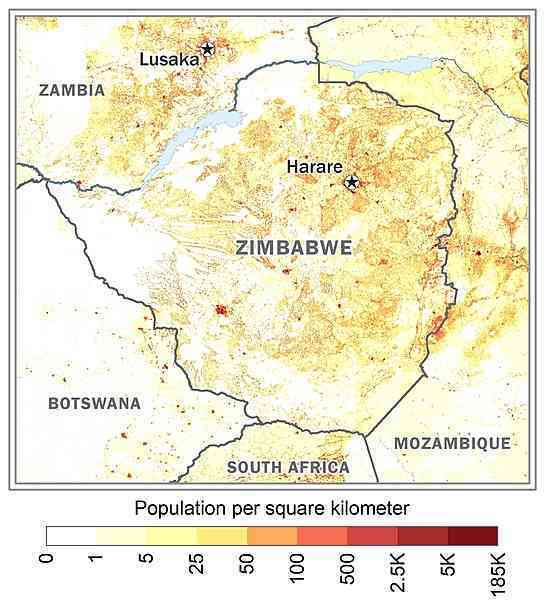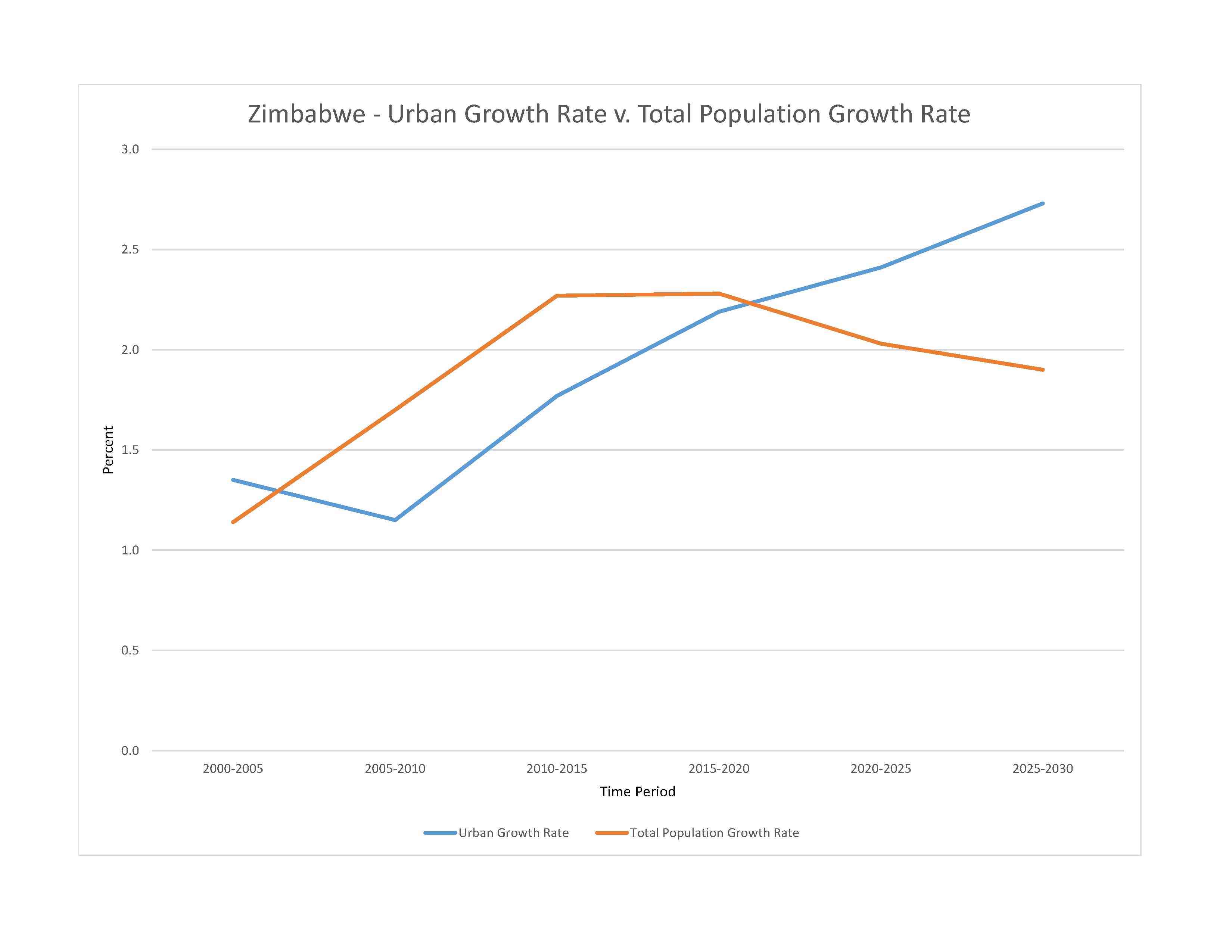
15,418,674 (2023 est.)
noun: Zimbabwean(s)
adjective: Zimbabwean
African 99.6% (predominantly Shona; Ndebele is the second largest ethnic group), other (includes caucasian, Asiatic, mixed race) 0.4% (2022 est.)
Shona (official; most widely spoken) 80.9%, Ndebele (official, second most widely spoken) 11.5%, English (official; traditionally used for official business) 0.3%, 13 minority languages (official; includes Chewa, Chibarwe, Kalanga, Koisan, Nambya, Ndau, Shangani, sign language, Sotho, Tonga, Tswana, Venda, and Xhosa) 7%, other 0.3% (2022 est.)
note: data represent population by mother tongue
Apostolic Sect 40.3%, Pentecostal 17%, Protestant 13.8%, other Christian 7.8%, Roman Catholic 6.4%, African traditionalist 5%, other 1.5% (includes Muslim, Jewish, Hindu), none 8.3% (2022 est.)
Zimbabwe’s progress in reproductive, maternal, and child health has stagnated in recent years. According to a 2010 Demographic and Health Survey, contraceptive use, the number of births attended by skilled practitioners, and child mortality have either stalled or somewhat deteriorated since the mid-2000s. Zimbabwe’s total fertility rate has remained fairly stable at about 4 children per woman for the last two decades, although an uptick in the urban birth rate in recent years has caused a slight rise in the country’s overall fertility rate. Zimbabwe’s HIV prevalence rate dropped from approximately 29% to 15% since 1997 but remains among the world’s highest and continues to suppress the country’s life expectancy rate. The proliferation of HIV/AIDS information and prevention programs and personal experience with those suffering or dying from the disease have helped to change sexual behavior and reduce the epidemic.
Historically, the vast majority of Zimbabwe’s migration has been internal – a rural-urban flow. In terms of international migration, over the last 40 years Zimbabwe has gradually shifted from being a destination country to one of emigration and, to a lesser degree, one of transit (for East African illegal migrants traveling to South Africa). As a British colony, Zimbabwe attracted significant numbers of permanent immigrants from the UK and other European countries, as well as temporary economic migrants from Malawi, Mozambique, and Zambia. Although Zimbabweans have migrated to South Africa since the beginning of the 20th century to work as miners, the first major exodus from the country occurred in the years before and after independence in 1980. The outward migration was politically and racially influenced; a large share of the white population of European origin chose to leave rather than live under a new black-majority government.
In the 1990s and 2000s, economic mismanagement and hyperinflation sparked a second, more diverse wave of emigration. This massive outmigration – primarily to other southern African countries, the UK, and the US – has created a variety of challenges, including brain drain, illegal migration, and human smuggling and trafficking. Several factors have pushed highly skilled workers to go abroad, including unemployment, lower wages, a lack of resources, and few opportunities for career growth.
0-14 years: 38.16% (male 2,920,951/female 2,962,652)
15-64 years: 57.32% (male 4,417,612/female 4,419,769)
65 years and over: 4.52% (2023 est.) (male 269,329/female 428,361)
total dependency ratio: 79.4
youth dependency ratio: 73.4
elderly dependency ratio: 6
potential support ratio: 16.6 (2021 est.)
total: 21 years (2023 est.)
male: 20.2 years
female: 21.8 years
1.99% (2023 est.)
29.4 births/1,000 population (2023 est.)
6.7 deaths/1,000 population (2023 est.)
-2.9 migrant(s)/1,000 population (2023 est.)
Aside from major urban agglomerations in Harare and Bulawayo, population distribution is fairly even, with slightly greater overall numbers in the eastern half as shown in this 
urban population: 32.5% of total population (2023)
rate of urbanization: 2.41% annual rate of change (2020-25 est.)

1.578 million HARARE (capital) (2023)
at birth: 1.03 male(s)/female
0-14 years: 0.99 male(s)/female
15-64 years: 1 male(s)/female
65 years and over: 0.63 male(s)/female
total population: 0.95 male(s)/female (2023 est.)
20.3 years (2015 est.)
note: data represents median age at first birth among women 25-49
357 deaths/100,000 live births (2020 est.)
total: 34 deaths/1,000 live births (2023 est.)
male: 37.7 deaths/1,000 live births
female: 30.2 deaths/1,000 live births
total population: 66.8 years (2023 est.)
male: 65.2 years
female: 68.5 years
3.51 children born/woman (2023 est.)
1.73 (2023 est.)
66.8% (2015)
improved: urban: 97.9% of population
rural: 66.9% of population
total: 76.9% of population
unimproved: urban: 2.1% of population
rural: 33.1% of population
total: 23.1% of population (2020 est.)
3.4% of GDP (2020)
0.2 physicians/1,000 population (2020)
1.7 beds/1,000 population (2011)
improved: urban: 96.1% of population
rural: 49% of population
total: 64.2% of population
unimproved: urban: 3.9% of population
rural: 51% of population
total: 35.8% of population (2017 est.)
degree of risk: high (2023)
food or waterborne diseases: bacterial and protozoal diarrhea, hepatitis A, and typhoid fever
vectorborne diseases: malaria, dengue fever, and sexually transmitted diseases: HIV/AIDS (2024)
water contact diseases: schistosomiasis
animal contact diseases: rabies
15.5% (2016)
total: 3.11 liters of pure alcohol (2019 est.)
beer: 1.2 liters of pure alcohol (2019 est.)
wine: 0.05 liters of pure alcohol (2019 est.)
spirits: 0.39 liters of pure alcohol (2019 est.)
other alcohols: 1.47 liters of pure alcohol (2019 est.)
total: 11.7% (2020 est.)
male: 21.8% (2020 est.)
female: 1.5% (2020 est.)
9.7% (2019)
61.6% (2023 est.)
women married by age 15: 5.4%
women married by age 18: 33.7%
men married by age 18: 1.9% (2019 est.)
3.9% of GDP (2018 est.)
definition: any person age 15 and above who completed at least grade 3 of primary education
total population: 89.7%
male: 88.3%
female: 90.9% (2021)
total: 11 years
male: 12 years
female: 11 years (2013)
NOTE: The information regarding Zimbabwe on this page is re-published from the 2024 World Fact Book of the United States Central Intelligence Agency and other sources. No claims are made regarding the accuracy of Zimbabwe 2024 information contained here. All suggestions for corrections of any errors about Zimbabwe 2024 should be addressed to the CIA or the source cited on each page.
This page was last modified 04 May 24, Copyright © 2024 ITA all rights reserved.